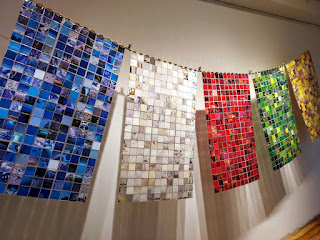My Little Black Books
I taught art for fifteen years. I loved my students but eventually realized that teaching, along with raising my children, left little time for Art. I couldn’t give up the children so I gave my notice and went back to the Art Students League. My friend, Rosina Florio, the director of the school, arranged for me to receive a grant that paid tuition for one class and an allowance for supplies. She insisted I study with Leo Manso, an abstractionist.
I resisted, thinking I wouldn’t get anything from a teacher whose aesthetic was so different from mine. I was mainly afraid that he’d be dismissive of my work. For a month I took a sculpture class. I was hiding out really, afraid to go to Manso. It was good to work in three dimensions, to use my hands and eyes in a different way but I knew I was going nowhere with sculpture. I gave in and went to Manso’s class.
He was formidable; not tall but sturdily build, with flowing hair and a mustache. He walked around the class quietly, the center of attention, looking at students’ work and commenting. When I showed him my drawings he said, “Well, I can see you’re a conscientious person…I see a lot of skill here…but nine to five isn’t art.”
I felt my lower lip tremble.
I’d worked so hard for that skill. I’d been taught that the answer to success is diligence. Hard work. Stick-toitiveness. All through school I was a day dreamer who finished nothing and now that I’d finally started working in a concentrated way, he said it wasn’t art.
I’m not sure why I didn’t zip up my portfolio and leave. I stayed and got to work.
I put away my pen and ink and bought a little blank book, six inches by nine, and wrote on the first page Leonardo DaVinci’s last words;
“If I could make...If I...”
The most important thing about my little book was that nobody was allowed to see it. I had thrown away for the moment everything I thought I'd achieved to try new stuff and I had to protect those raw new ideas.
I never thought of myself as a writer but that first book is full of words; some my own and many many quotes.
“You won’t lose yourself, you’ll find something in yourself you might not have known was there.”
"Tired subjects redeemed by freshness of context."
"The dizzyness of too much possibility.
Manso said;“Art should be psychologically relevant, aesthetically pleasing and well crafted.” That felt like something I could work toward.
"If it's not working, check the balance-size, shape...
repetition--is it subtle variations on a theme or just boring?"
"Don't be book-endish."
I kept coming back to diligence; "Diligence is the mother of good fortune".Then in my own thoughts, Diligence is driving me crazy.
Then, from my dear friend and wise counselor, Lenesa, "Keep talking and writing. Use the words."
Page after page, some abstract, playing with form and color, making odd juxtapositions of images and textures. I raced through the New York Times every morning and grabbed things--I was open to any kind of delight.
I thought about the artists who spoke to me, who had something I could use--or steal. I loved Hans Holbein’s pencil drawing of Lady Cecily Heron, the daughter-in-law of Sir Thomas More, with her wonderful name and her sharp sideways glance. Holbein put so much meaning and life into those few pencil lines. I made lots of xerox copies and played with her image. Her she is gazing at a young Georgia O’Keeffe.
| I quit thinking of my work as a way to please someone else. I was working just for me, looking for my own reality. It was liberating. Here’s a quote; “I feel so much at sea--feel enormous conflict, almost like isometric exercise a beast standing at the gate. This is fear of success because it’s competition with M...Also wonder if I’m working to please Manso What’s good and what’s not? When it works I really don’t know why. Not really interested in being Braque or even Stuart Davis. Little work this week but hugely upheaving and searching.” I was like a tempest, bringing up treasures from the bottom of the sea and casting them onto the beach for further use. I was having a great time, intensely involved in my work. Mark Summers' portraits were great fun to play with. Here's LBJ and a carousel horse. At the end of that year I thanked him. “I know my work is different from your aesthetic but you really helped me.” He said, “I can tell when someone is serious.” Rosina was right. Manso had plenty to teach me. there are elements of color, composition and form that transcend genres and we worked on those. But what he really gave me was a sense that it was safe to open up to possibilities, and if I say it’s interesting or worth while well then, dammit, it is. I didn’t have to give up my hard earned diligence, so rooted in my family history; all I had to do was merge it with my sense of fun, of looking at things from a different angle. and recognizing that my odd angle was valid. |









Comments
Post a Comment